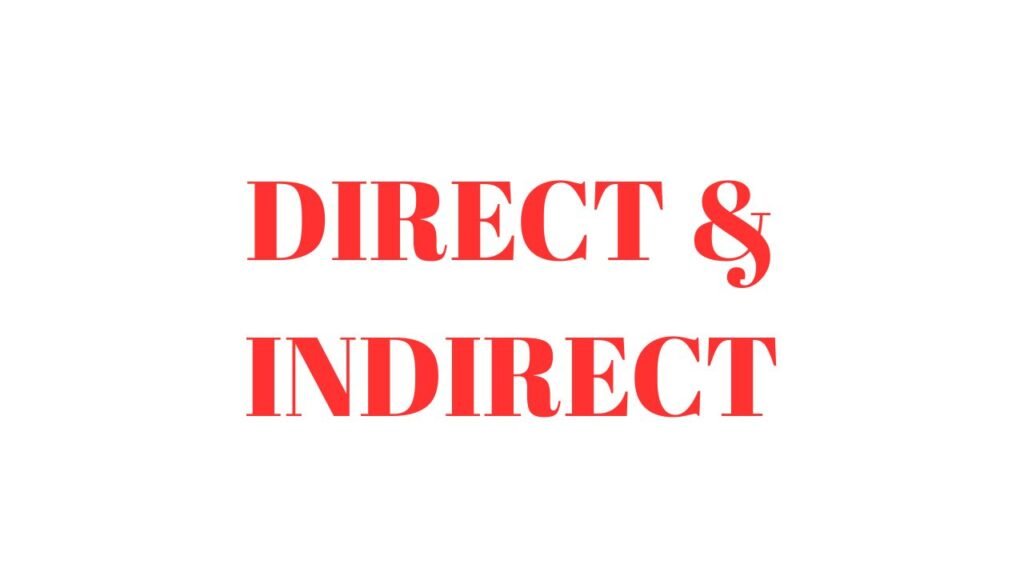
Direct & Indirect – क्या आपने कभी किसी की बात को अपने शब्दों में दोहराया है?
जैसे – “Mohan said, ‘I am happy.'” को “Mohan said that he was happy.” में बदल दिया?
यही Direct और Indirect Speech का कमाल है!
What is Direct & Indirect?
📌 Direct Speech in Direct & Indirect
जब हम किसी की कही हुई बात को ठीक वैसे ही दोहराते हैं, बिना कोई बदलाव किए, तब वह Direct Speech कहलाती है।
✅ Example:
🔹 Rahul said, “I love cricket.”
(यहाँ हम Rahul की बात को ज्यों का त्यों दोहरा रहे हैं।)
📌 Indirect Speech in Direct & Indirect
जब हम किसी की कही हुई बात को अपने शब्दों में बदलकर कहते हैं, तब उसे Indirect Speech कहते हैं।
✅ Example:
🔹 Rahul said that he loved cricket.
(यहाँ हमने “I” को “he” में बदल दिया और “love” को “loved” में।)
💡 सोचिए और बताइए!💡
अगर दोस्त आपको कहते हैं – “I will meet you tomorrow.”
तो आप इसे Indirect Speech में कैसे बदलेंगे? जवाब नीचे कमेंट में लिखिए! 👇
Direct and Indirect Speech Rules
📌 1. Pronoun Change (सर्वनाम में बदलाव)
Indirect Speech में Subject और Object के अनुसार Pronoun बदल जाते हैं।
✅ Example:
🔹 He said, “I am busy.” → He said that he was busy.
🔹 She said, “We love dancing.” → She said that they loved dancing.
📌 2. Tense Change (काल में बदलाव)
DIRECT & INDIRECT मे हम अगर Reporting Verb (said, told) Past Tense में है, तो Reported Speech का Tense बदल जाता है।
| Direct Speech | Indirect Speech |
|---|---|
| Present Simple → “I eat an apple.” | Past Simple → He said that he ate an apple. |
| Present Continuous → “I am reading a book.” | Past Continuous → He said that he was reading a book. |
| Present Perfect → “I have finished my work.” | Past Perfect → He said that he had finished his work. |
| Past Simple → “I went to Delhi.” | Past Perfect → He said that he had gone to Delhi. |
| Will → “I will help you.” | Would → He said that he would help me. |
❌ No Tense Change in Universal Truths!
🔹 She said, “The sun rises in the east.” → She said that the sun rises in the east.
3.Direct & Indirect में Time & Place Words Change (समय और स्थान बदलते हैं)
DIRECT & INDIRECT मे हम अगर कुछ शब्द Indirect Speech में बदल जाते हैं:
| Direct Speech | Indirect Speech |
|---|---|
| Today → “I am busy today.” | That day → He said that he was busy that day. |
| Tomorrow → “I will go tomorrow.” | The next day → He said that he would go the next day. |
| Yesterday → “I saw him yesterday.” | The previous day → He said that he had seen him the previous day. |
| Now → “I am happy now.” | Then → He said that he was happy then. |
| This → “I like this book.” | That → He said that he liked that book. |
| Here → “I am here.” | There → He said that he was there. |
📌 4. Reporting Verb Change (कहने वाले शब्द बदलते हैं)
- Said to → Told
- Say → Said
- Ask → जब सवाल हो
- Request / Order → जब अनुरोध या आदेश हो
✅ Example:
🔹 He said to me, “Open the door.” → He told me to open the door.
🔹 She said, “Please help me.” → She requested me to help her.
📌 5. Question और Imperative Sentences में बदलाव
- Yes/No Questions → if/whether जोड़ते हैं।
✅ Example:
🔹 He said, “Do you like tea?” → He asked if I liked tea. - WH-Questions (What, Where, Why, etc.) → WH-Word को वैसे ही रखते हैं।
✅ Example:
🔹 She said, “Where are you going?” → She asked where I was going. - Commands & Requests → To + Verb जोड़ते हैं।
✅ Example:
🔹 He said, “Close the window.” → He told me to close the window.
💡 Challenge for You! (सोचिए और बताइए!)
अगर कोई कहे – “I am watching a movie now.”
तो आप इसे Indirect Speech में कैसे बदलेंगे? 🤔
अपना जवाब कमेंट में लिखिए! 👇
“Says to” and “Say to” in Direct & Indirect Speech
Usage of “Say” and “Says”
- “Say” is used in the present tense with I, we, you, they, plural subjects.
- “Says” is used in the present tense with he, she, it, singular subjects.
- “Say” and “Says” are used in direct speech but require “to” before the object if mentioning whom we are speaking to.
✅ Examples:
🔹 Direct: He says to me, “I like coffee.”
🔹 Indirect: He tells me that he likes coffee.
🔹 Direct: She says to them, “You are my best friends.”
🔹 Indirect: She tells them that they are her best friends.
Rules for Changing “Say to” and “Says to” in Indirect Speech
- “Say to” / “Says to” changes into “Tell” / “Tells”
- Direct: She says to me, “You are kind.”
- Indirect: She tells me that I am kind.
- If there is no object after “say,” it remains unchanged.
- Direct: He says, “The earth is round.”
- Indirect: He says that the earth is round.
- In past tense, “said to” changes into “told.”
- Direct: He said to me, “You are my friend.”
- Indirect: He told me that I was his friend.
Exercise (Convert Direct to Indirect Speech)
- She says to me, “I love reading books.”
- He says to them, “You should work hard.”
- The teacher says to us, “Honesty is the best policy.”
- She says, “I am happy today.”
- They say to him, “You sing well.”

One thought on “English Direct & Indirect Chapter Deep You Read this”
Comments are closed.